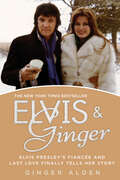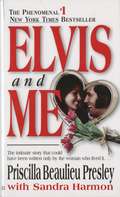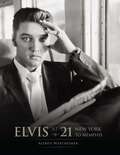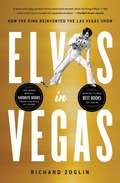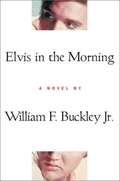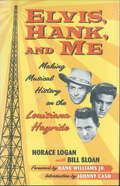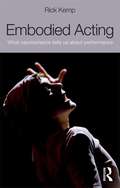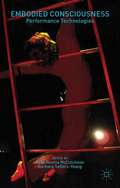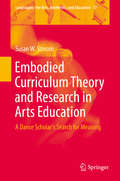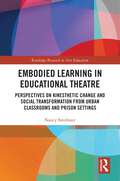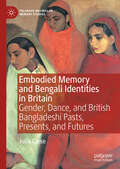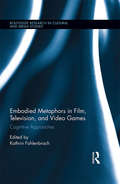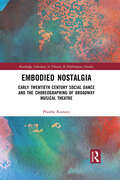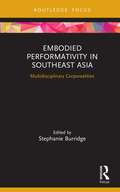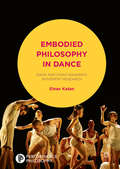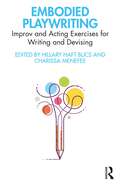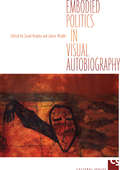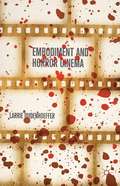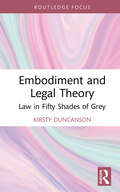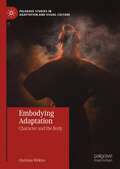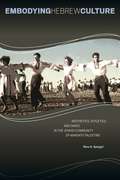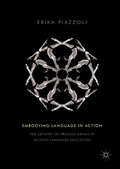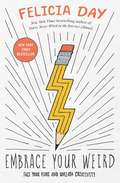- Table View
- List View
Elvis and Ginger: Elvis Presley's Fiancée and Last Love Finally Tells Her Story
by Ginger AldenELVIS PRESLEY'S FIANCÉE AND LAST LOVE FINALLY TELLS HER STORY "Elvis, you and I know the truth and unfortunately you're not here to set the record straight. With this book, I will try to..." Elvis Presley and Graceland were fixtures in the life of Ginger Alden, having been born and raised in Memphis, Tennessee. But she had no idea that she would play a part in that enduring legacy--as Elvis Presley's fiancée, and his last great love. For over three decades Ginger has held the truth of their relationship close to her heart. Now she shares her unique story, and while a lot has been written about the King, the Elvis we meet in this long-anticipated memoir is a revelation. In her own words Ginger details their whirlwind romance--from first kiss to his stunning proposal of marriage. She details his exploration of Eastern religions, his perception of being a "legend," his devotion to family and friends, and her attempt to know the insular group surrounding Elvis. And for the very first time she talks about the devastating end of it all, and the 50,000 mourners and reporters who descended on Graceland in 1977, exposing Ginger to the reality of living in the spotlight of a short, yet immortal, life. Above it all, Alden rescues Elvis from the hearsay, rumors, and tabloid speculations of his final year by shedding a frank yet personal light on a very public legend. From a unique and intimate perspective, she reveals the man--complicated, romantic, fallible, and human--behind the enduring myth, a superstar worshipped by millions, and loved by Ginger Alden. INCLUDES PHOTOS
Elvis and Me
by Priscilla Presley Sandra HarmonElvis and Me is the unforgettable memoir of Elvis Presley. This New York Times bestseller reveals the intimate story that could only be written by the woman who lived it. It serves as a tribute to the man as well as the King of Rock n' Roll.
Elvis at 21: New York to Memphis
by Insight EditionsIn 1956, photographer Alfred Wertheimer was asked to photograph the then twenty-one-year-old Elvis Presley just as his career was about to explode. This book features the collection of photos taken by Wertheimer, offering a snapshot of the young Elvis Presley&’s remarkable rise to fame and his permanent status as the &“King of Rock &’n&’ Roll.&” In 1956, Alfred Wertheimer was asked by Presley&’s new label, RCA Victor, to photograph Elvis Presley&’s budding career just as it was about to take off in a way the world had never seen. With unimpeded access to the young performer, Wertheimer captured unguarded and everyday moments in Elvis&’s life during that crucial year. It was a year that took him from Tupelo, Mississippi, to the silver screen, the verge of international stardom, and his crowning as the &“King of Rock 'n' Roll.&” As Wertheimer photographed Elvis during 1956, and again in 1958, he created classic images that are spontaneous, unrehearsed, and without artifice. A PIVOTAL YEAR: Dubbed the &“King of Rock &’n&’ Roll&” in 1956, 21-year-old Elvis, placed 17 songs on Billboard&’s Top 100 singles chart, including 3 singles that reached #1, appeared multiple prime-time TV variety shows, performed 143 times in 79 different cities, and released his first film, Love Me Tender EXCLUSIVE PHOTOS: Dive into the complete collection of Alfred Wertheimer&’s photos of the young Elvis Presley as he tours from New York to Memphis, Tennessee PERFECT FOR ALL ELVIS FANS: Fans of all ages will enjoy this exclusive deep dive into Elvis&’s early life as he builds his career and shakes up the world of music GO BEHIND THE STAGE: Explore intimate and candid images captured after Elvis has left the building—backstage, writing, or reading fan mail from his admirers RENOWNED PHOTOGRAPHER AND AUTHOR: Experience the King of Rock &’n&’ Roll through the lens of famed Alfred Wertheimer, the photographer who captured every moment of the young star&’s early career
Elvis in Vegas: How the King Reinvented the Las Vegas Show
by Richard ZoglinThe story of how Las Vegas saved Elvis and Elvis saved Las Vegas in the greatest musical comeback of all time.The conventional wisdom is that Las Vegas is what destroyed Elvis Presley, launching him on a downward spiral of drugs, boredom, erratic stage behavior, and eventually his fatal overdose. But in Elvis in Vegas, Richard Zoglin takes an alternate view, arguing that Vegas is where the King of Rock and Roll resurrected his career, reinvented himself as a performer, and created the most exciting show in Vegas history. Elvis’s 1969 opening night in Vegas was his first time back on a live stage in more than eight years. His career had gone sour—bad movies, and mediocre pop songs that no longer made the charts. He’d been dismissed by most critics as over the hill. But in Vegas he played the biggest showroom in the biggest hotel in the city, drawing more people for his four-week engagement than any other show in Vegas history. His performance got rave reviews, “Suspicious Minds” gave him his first number-one hit in seven years, and Elvis became Vegas’s biggest star. Over the next seven years, he performed more than 600 shows there, and sold out every one. Las Vegas was changed too. The intimate night-club-style shows of the Rat Pack, who made Vegas the nation’s premier live-entertainment center in the 1950s and ‘60s, catered largely to well-heeled older gamblers. Elvis brought a new kind of experience: an over-the-top, rock-concert-like extravaganza. He set a new bar for Vegas performers, with the biggest salary, the biggest musical production, and the biggest promotion campaign the city had ever seen. In doing so, he opened the door to a new generation of pop/rock performers, and brought a new audience to Vegas—a mass audience from Middle America that Vegas depends on for its success to this day. A classic comeback tale set against the backdrop of Las Vegas’s golden age, Richard Zoglin’s Elvis in Vegas is a feel-good story for the ages.
Elvis in the Morning
by William F. Buckley Jr.Orson is a young boy whose mother works at a U.S. Army base in Germany in the 1950s. There, he becomes a fan of a G.I. stationed at the base, one Elvis Presley, whose music is played over and over on the radio. When Orson is caught stealing recordings of Elvis's tunes from the PX, the attendant publicity catches the star's attention, and he comes to visit his young fan. Thus begins a lifelong friendship. As Elvis's career rockets ever higher and his behavior becomes ever more erratic, the two share many adventures. The sixties explode, and Elvis becomes the icon of the nation, while Orson, a college demonstrator, drifts away from regular life while looking for something of substance to believe in. Each man is an emblem of his time, as social conventions crumble, barriers fall, and the cultural landscape changes forever.
Elvis, Hank, and Me: Making Musical History on the Louisiana Hayride
by Bill Sloan Horace LoganIn 1948, Horace "Hoss" Logan, a young radio producer in Shreveport, Louisiana, started booking talent for a new weekly music show called the Louisiana Hayride. Performed for a live audience and broadcast nationally over the CBS Radio network, the show became known as the "Cradle of the Stars." In this affectionate memoir, Hoss Logan recalls the Hayride's heyday with behind-the-scenes anecdotes about the dozens of musicians he knew and nurtured, including Johnny Cash, Johnny Horton, George Jones, Willie Nelson, Elvis Presley, Jim Reeves, Kitty Wells, Slim Whitman, Hank Williams, Faron Young, and many more. As producer, emcee, and friend to the Hayride performers, Logan gives us a personal look into musical history - from Hank Williams's ups and downs to the teenage Elvis's first performance on national radio to the ways the Hayride's many emerging stars expanded our idea about what country music could be.
Elvis, Strait, to Jesus: An Iconic Producer's Journey with Legends of Rock 'n' Roll, Country, and Gospel Music
by Tony BrownThis striking photographic journey shows how Tony Brown became the King of Nashville: from pianist for Elvis Presley, to president of MCA Records Nashville, to producer of over 100 number-one country songs that are beloved by millions. ELVIS, STRAIT, TO JESUS celebrates a music icon's legendary rise, his history-making industry relationships, and how these friendships gave us the songs we still live by.The magic of Tony Brown's forty-year career is revealed in pictures, with historical and behind-the-scenes images, snapshots from the "Elvis years," and stylish contemporary portraits staged in a French Renaissance chair of friends, musicians, and artists including:George Strait - Reba McEntire - Trisha Yearwood - Brooks & Dunn - Vince Gill - Lionel Richie - Lyle Lovett - Patty Loveless - Steve Earle - Rosanne Cash - Emmylou Harris - Jimmy Buffett - Marty Stuart - Bernie Taupin - Don Was - William Lee Golden - Rodney Crowell - David Briggs - Glen D. Hardin - Donnie Sumner, and more.Tony's fascinating anecdotes accompanying the photos unveil the encounters that led to mega-hits by George Strait, Reba McEntire, Trisha Yearwood, and countless others; he recounts how he became the accidental founder of Americana music with the edgy signings of Steve Earle and Lyle Lovett to MCA, as well as his unforgettable memories of life on tour with Elvis Presley. He also retraces his North Carolina roots and honors the legends of rock, country, and gospel with whom he forged an inimitable music legacy. This special tribute is one that no fan of music or artistic photography should be without.
Embodied Acting: What Neuroscience Tells Us About Performance
by Rick Kemp‘A focus on the body, its actions, and its cognitive mechanisms identifies ... foundational principles of activity that link the three elements of theatre; Story, Space, and Time. The three meet in, are defined by, and expressed through the actor’s body.’ – from the Introduction Embodied Acting is an essential, pragmatic intervention in the study of how recent discoveries within cognitive science can – and should – be applied to performance. For too long, a conceptual separation of mind and body has dominated actor training in the West. Cognitive science has shown this binary to be illusory, shattering the traditional boundaries between mind and body, reason and emotion, knowledge and imagination. This revolutionary new volume explores the impact that a more holistic approach to the "bodymind" can have on the acting process. Drawing on his experience as an actor, director and scholar, Rick Kemp interrogates the key cognitive activities involved in performance, including: non-verbal communication the relationship between thought, speech, and gesture the relationship between self and character empathy, imagination, and emotion. New perspectives on the work of Stanislavski, Michael Chekhov, and Jacques Lecoq – as well as contemporary practitioners including Daniel Day-Lewis and Katie Mitchell – are explored through practical exercises and accessible explanations. Blending theory, practice, and cutting-edge neuroscience, Kemp presents a radical re-examination of the unconscious activities engaged in creating, and presenting, a role.
Embodied Consciousness: Performance Technologies
by Barbara Sellers-Young Jade Rosina MccutcheonThis volume of essays combines research from neuroscience, conscious studies, methods of training performers, modes of creating a staged narrative, Asian aesthetics, and post-modern theories of performance in an examination of the relationship between consciousness and performance.
Embodied Curriculum Theory and Research in Arts Education
by Susan W. StinsonThis collection of articles by Susan W. Stinson, organized thematically and chronologically by the author, reveals the evolution of the field of arts education in general and dance education in particular, through narrative and critical reflections by this unique scholar and a few co-authors. It also includes contextual insights not available elsewhere. The author's pioneering embodied research work in arts and dance education continues to be relevant to researchers today. The selected chapters and articles were predominantly previously published in a variety of journals, conference proceedings and books between 1985 and the present. Each section is preceded by an introduction and the author has written a post scriptum for each article to offer a commentary or response to the article from the current perspective.
Embodied Human–Computer Interaction in Vocal Music Performance (Springer Series on Cultural Computing)
by Franziska BaumannThis SpringerBrief provides a unique insight into the practice and research of the connections between voice, HCI and embodiment. Specifically, it explores how the voice can be embodied and mediated by means of gestural communication through sensor interfaces and aims to situate and contextualise various aspects that generate meaningful connections in such interactive interface performance. The author offers an approach for understanding creative practices between humans and computers in gestural live music performance, from the perspective of the embodied relationships created within such systems. Underlying practices, principles and sensor technologies that support creativity in embodied human-computer interaction in vocal music performance are examined and a dynamic framework and tools for anyone wishing to engage with this subject in depth are presented. The book is essential reading not only for musicians, composers, researchers, application developers, musicologists and educators but also for students and tertiary institutions as well as actors and dramaturgs in a music context.
Embodied Learning in Educational Theatre: Perspectives on Kinesthetic Change and Social Transformation from Urban Classrooms and Prison Settings (Routledge Research in Arts Education)
by Nancy SmithnerThis book explores embodied teaching practices through applied and physical theatre, drawing extensively on the author’s rich experience teaching in diverse urban environments, including schools, colleges and prison settings.It presents a groundbreaking conceptualization of embodied practice aimed at fostering personal and social growth through educational theatre. Each chapter delves into theories of social transformation, supported by qualitative data from student reflections, to provide both theoretical and practical insights. These insights illustrate how physicalized pedagogy can be effectively used to engage students with socially transformative ideas and identities. It also emphasizes the significant role of the facilitator in this process, highlighting how they can create an environment that fosters ethical and multicultural awareness in both formal educational settings, such as classrooms, and informal settings, like community workshops. By promoting an ethos of inclusivity and ethical consideration, it argues that facilitators can help students navigate and engage with complex social issues through the medium of theatre.An accessible and compelling text, it aims to inspire educators to adopt innovative methods that promote deeper engagement and understanding among students.
Embodied Memory and Bengali Identities in Britain: Gender, Dance, and British Bangladeshi Pasts, Presents, and Futures (Palgrave Macmillan Memory Studies)
by Julia GieseThis book provides insight into the relationship between embodied processes and products of remembering and belonging among British Bangladeshi women in Tower Hamlets, London. Based on an analysis of memories performed in both professional and social dancing among British Bangladeshi women, as well as of the spaces and encounters that enable the production, transmission, and negotiation of such memories, this book addresses questions about the relationship between remembering and identification in the diaspora.
Embodied Metaphors in Film, Television, and Video Games: Cognitive Approaches (Routledge Research in Cultural and Media Studies)
by Kathrin FahlenbrachIn cognitive research, metaphors have been shown to help us imagine complex, abstract, or invisible ideas, concepts, or emotions. Contributors to this book argue that metaphors occur not only in language, but in audio visual media well. This is all the more evident in entertainment media, which strategically "sell" their products by addressing their viewers’ immediate, reflexive understanding through pictures, sounds, and language. This volume applies cognitive metaphor theory (CMT) to film, television, and video games in order to analyze the embodied aesthetics and meanings of those moving images.
Embodied Nostalgia: Early Twentieth Century Social Dance and the Choreographing of Broadway Musical Theatre (Routledge Advances in Theatre & Performance Studies)
by Phoebe RumseyEmbodied Nostalgia is a collection of interlocking case studies that focus on how social dance in musical theatre brings forth the dancer on stage as a site of embodied history, cultural memory, and nostalgia, and asks what social dance is doing performatively, dramaturgically, and critically in musical theatre. The case studies in this volume are all Broadway musicals set during the Jazz Age (1910-1950), however, performed and produced after that time, creating a spectrum of nostalgic impulses that are interrogated for social and political resonance and meaning. All reflect the fractures or changes in the social dance when brought to the stage and expose the complexities of the embodied nostalgia – broadly interpreted as the physicalizing of community memories, longings, and historical meaning – the dances carry with them. Particular attention is focused on the Black ownership of the social dances and the subsequent appropriation, cultural theft, and forgotten legacies. By approaching musical theatre through this lens of social dance––always already deeply connected to notions of class and race––and the politics of choreography therein, a unique and necessary method to describing, discussing, and critically evaluating the body in motion in musical theatre is put forth.
Embodied Performativity in Southeast Asia: Multidisciplinary Corporealities (Routledge Contemporary Southeast Asia Series)
by Stephanie BurridgeA collection presenting cutting edge research from music, dance, performance art, fashion and visual arts, written by scholar-practitioners working in Southeast Asia. This eclectic monograph explores multi-disciplinarily performativity through the body. Exploring the notion of the body as central to creative practice it draws together conversations centring on innovation through embodied knowledge relating to space, time and place. The authors in this collection are leaders in their field and recognized internationally. Their chapters represent new directions in thought and practice by game-changers in the arts. Underpinned by a central theme of corporeality, it is bold and innovative in its scope and range, bringing diverse disciplines together. It enables connections that create new ways of critically exploring corporeality extending beyond physicality and the traditional body-centred areas of performing arts practice. Insightful and stimulating reading for students, scholars and practitioners across the tertiary arts sector, as well as education, therapy, cultural studies and interdisciplinary arts.
Embodied Philosophy in Dance
by Einav KatanRepresenting the first comprehensive analysis of Gaga and Ohad Naharin's aesthetic approach, this book following the sensual and mental emphases of the movement research practiced by dancers of the Batsheva Dance Company. Considering the body as a means of expression, Embodied Philosophy in Dance deciphers forms of meaning in dance as a medium for perception and realization within the body. In doing so, the book addresses embodied philosophies of mind, hermeneutics, pragmatism, and social theories in order to illuminate the perceptual experience of dancing. It also reveals the interconnections between physical and mental processes of reasoning and explores the nature of physical intelligence.
Embodied Playwriting: Improv and Acting Exercises for Writing and Devising
by Hillary Haft Bucs Charissa MenefeeEmbodied Playwriting: Improv and Acting Exercises for Writing and Devising is the first book to compile new and adapted exercises for teaching playwriting in the classroom, workshop, or studio through the lens of acting and improvisation. The book provides access to the innovative practices developed by seasoned playwriting teachers from around the world who are also actors, improv performers, and theatre directors. Borrowing from the embodied art of acting and the inventive practice of improvisation, the exercises in this book will engage readers in performance-based methods that lead to the creation of fully imagined characters, dynamic relationships, and vivid drama. Step-by-step guidelines for exercises, as well as application and coaching advice, will support successful lesson planning and classroom implementation for playwriting students at all levels, as well as individual study. Readers will also benefit from curation by editors who have experience with high-impact educational practices and are advocates for the use of varied teaching strategies to increase accessibility, inclusion, skill-building, and student success. Embodied Playwriting offers a wealth of material for teachers and students of playwriting courses, as well as playwrights who look forward to experimenting with dynamic, embodied writing practices.
Embodied Politics in Visual Autobiography
by Sarah Brophy Janice HladkiFrom reality television to film, performance, and video art, autobiography is everywhere in today's image-obsessed age. With contributions by both artists and scholars, Embodied Politics in Visual Autobiography is a unique examination of visual autobiography's involvement in the global cultural politics of health, disability, and the body. This provocative collection looks at images of selfhood and embodiment in a variety of media and with a particular focus on bodily identities and practices that challenge the norm: a pregnant man in cyberspace, a fat activist performance troupe, indigenous artists intervening in museums, transnational selves who connect disability to war, and many more.The chapters in Embodied Politics in Visual Autobiography reflect several different theoretical approaches but share a common concern with the ways in which visual culture can generate resistance, critique, and creative interventions. With contributions that investigate digital media, installation art, graphic memoir, performance, film, reality television, photography, and video art, the collection offers a wide-ranging critical account of what is clearly becoming one of the most important issues in contemporary culture.
Embodiment And Horror Cinema
by Larrie DudenhoefferUsing the four tissue types (connective, epithelial, nervous, and muscular), Dudenhoeffer expands and complicates the subgenre of "body horror. " Changing the emphasis from the contents of the film to the "organicity" of its visual and affective registers, he addresses the application of psychoanalysis, phenomenology, object-ontology, and cyborgism.
Embodiment and Legal Theory: Law in Fifty Shades of Grey
by Kirsty DuncansonThis book addresses the importance of the body in legal theory, through an analysis of the film Fifty Shades of Grey.As physical beings, we experience law in sensations of outrage when it is applied unethically, righteousness when it finds justice, and joy when it establishes partnerships in marriage. Our bodies feel and know law. In Embodiment and Legal Theory, it is argued that our bodies also theorise law. It is proposed that our bodies are involved in comprehending, negotiating, and reimagining the legal concepts that shape our lives. As a medium designed to engage us by stimulating our bodily reactions of tears, laughter, shock, and titillation, cinema provides an ideal site for exploring how bodies participate in legal arguments and the construction of legal meaning. For this reason, through a deep analysis of the film Fifty Shades of Grey (2015), this book presents a theory of embodied jurisprudence.At the intersection of legal theory and film studies, this book will appeal to students and scholars in both these areas, as well as in criminology and cultural studies.
Embodying Adaptation: Character and the Body (Palgrave Studies in Adaptation and Visual Culture)
by Christina WilkinsThis book explores the impact of the body on the mediation of character in adaptations. Specifically, it thinks about how identity is shaped by the body and how this alters meanings of adaptations. With an increasingly digital world, the importance of the body may be seen as diminishing. However, the book highlights the different political and social meanings the body signifies, which in turn renders character. Through a discussion of adaptations of sexuality, race, and mental difference, the mediation of character is shown to be tied to the physical. The book challenges the hierarchies in place both for the understanding of character, which privileges the actor, and in adaptations, which privileges the original. The discussion of the body, character, and adaptation asserts that the meanings the physical has in its shaping of, and by, character in adaptations reflect the way in which we position our own bodies in the world.
Embodying Hebrew Culture: Aesthetics, Athletics, and Dance in the Jewish Community of Mandate Palestine
by Nina S. SpiegelFrom their conquest of Palestine in 1917 during World War I, until the establishment of the State of Israel in 1948, the British controlled the territory by mandate, representing a distinct cultural period in Middle Eastern history. In Embodying Hebrew Culture: Aesthetics, Athletics, and Dance in the Jewish Community of Mandate Palestine, author Nina S. Spiegel argues that the Jewish community of this era created enduring social, political, religious, and cultural forms through public events, such as festivals, performances, and celebrations. She finds that the physical character of this national public culture represents one of the key innovations of Zionism-embedding the importance of the corporeal into national Jewish life-and remains a significant feature of contemporary Israeli culture. Spiegel analyzes four significant events in this period that have either been unexplored or underexplored: the beauty competitions for Queen Esther in conjunction with the Purim carnivals in Tel Aviv from 1926 to 1929, the first Maccabiah Games or "Jewish Olympics" in Tel Aviv in 1932, the National Dance Competition for theatrical dance in Tel Aviv in 1937, and the Dalia Folk Dance Festivals at Kibbutz Dalia in 1944 and 1947. Drawing on a vast assortment of archives throughout Israel, Spiegel uses an array of untapped primary sources, from written documents to visual and oral materials, including films, photographs, posters, and interviews. Methodologically, Spiegel offers an original approach, integrating the fields of Israel studies, modern Jewish history, cultural history, gender studies, performance studies, dance theory and history, and sports studies. In this detailed, multi-disciplinary volume, Spiegel demonstrates the ways that political and social issues can influence a new society and provides a dynamic framework for interpreting present-day Israeli culture. Students and teachers of Israel studies, performance studies, and Jewish cultural history will appreciate Embodying Hebrew Culture.
Embodying Language in Action: The Artistry of Process Drama in Second Language Education
by Erika PiazzoliThis book explores embodiment in second language education, sociocultural theory and research. It focuses on process drama, an embodied approach that engages learners’ imagination, body and voice to create a felt-experience of the second language and culture. Divided into three parts, it begins by examining the aesthetic and intercultural dimension of performative language teaching, the elements of drama and knowing-in-action. The central part of the book examines issues related to play, emotions, classroom discourse and assessment when learning a language through process drama, in a sociocultural perspective. The third part is an analysis of the author’s qualitative research, which informs a subtle discussion on reflective practitioner methodology, learner engagement and teacher artistry. Each chapter includes a drama workshop, illustrating in practice what embodying language in action can look like when working with asylum seekers, adult learners with intellectual disabilities, pre-service teachers, international students and children involved in a Content and Language Integrated Learning (CLIL) programme. A unique combination of theory, research and reflective practice, this book provides valuable insights for teacher/artists, teacher educators and researchers in the fields of performative and sociocultural language learning.
Embrace Your Weird: Face Your Fears and Unleash Creativity
by Felicia DayIn Embrace Your Weird, New York Times bestselling author, producer, actress, TV writer, and award-winning web series creator, Felicia Day takes you on a journey to find, rekindle, or expand your creative passions. Including Felicia’s personal stories and hard-won wisdom, Embrace Your Weird offers: —Entertaining and revelatory exercises that empower you to be fearless, so you can rediscover the things that bring you joy, and crack your imagination wide open —Unique techniques to vanquish enemies of creativity like: anxiety, fear, procrastination, perfectionism, criticism, and jealousy —Tips to cultivate a creative community —Space to explore and get your neurons firing Whether you enjoy writing, baking, painting, podcasting, playing music, or have yet to uncover your favorite creative outlet, Embrace Your Weird will help you unlock the power of self-expression. Get motivated. Get creative. Get weird.
